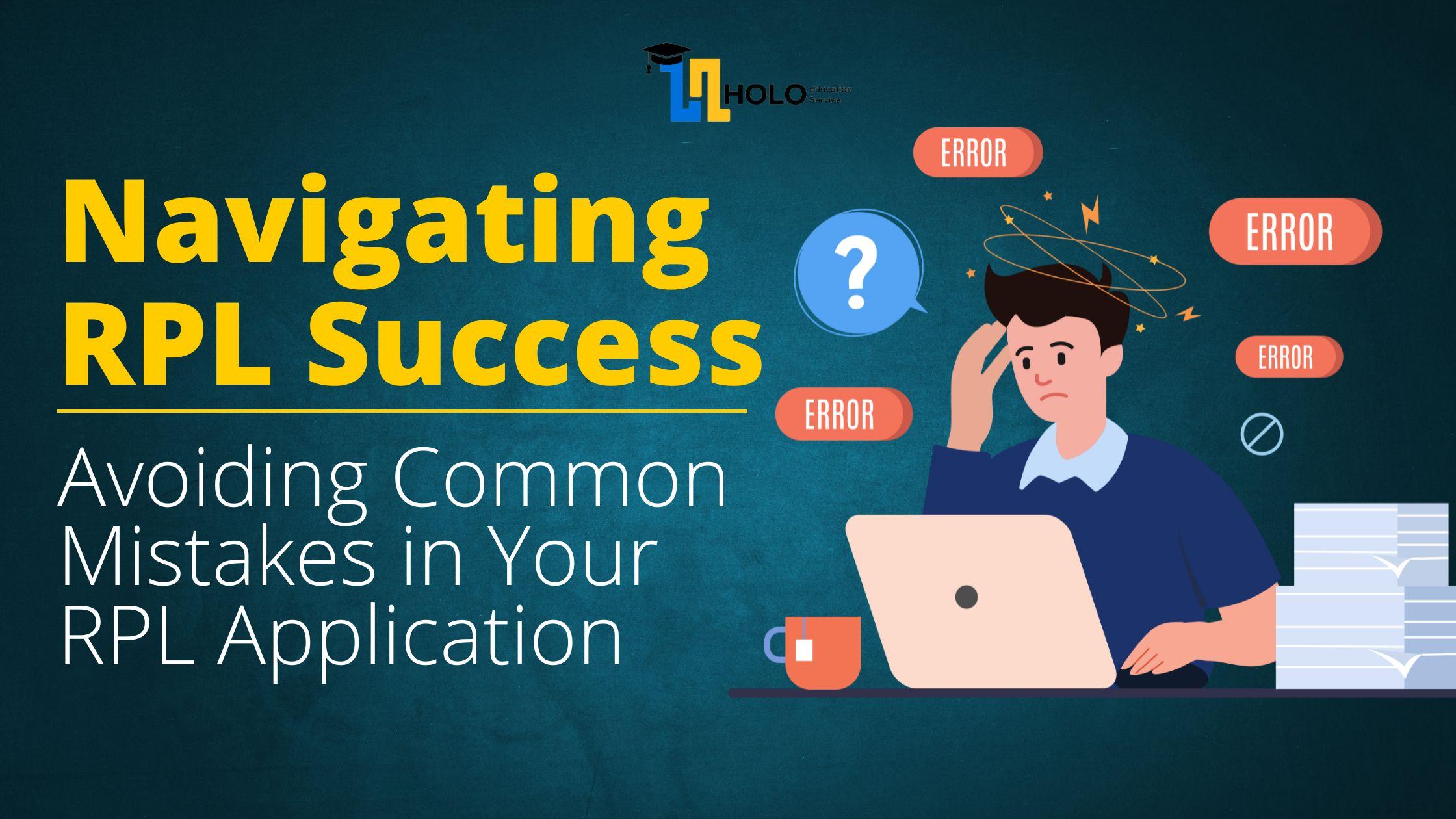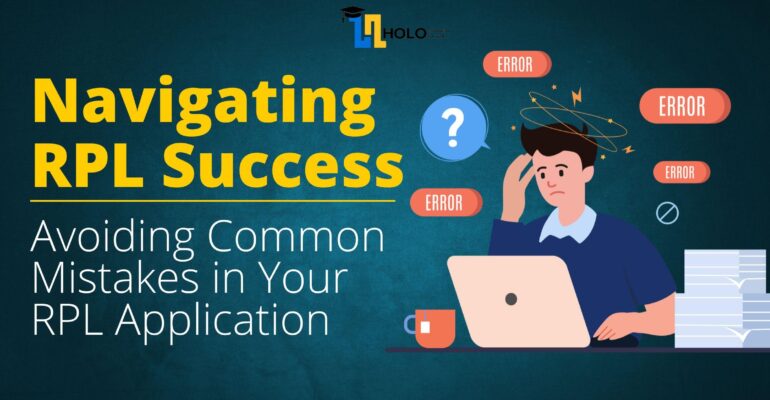Navigating RPL Success: Avoiding Common Mistakes in Your RPL Application
May 19, 2023 2023-05-19 5:43Navigating RPL Success: Avoiding Common Mistakes in Your RPL Application
Navigating RPL Success: Avoiding Common Mistakes in Your RPL Application

Certainly! Here’s a blog on the topic “Common Mistakes to Avoid When Applying for RPL”:
Recognition of Prior Learning (RPL) is a valuable pathway for individuals in Australia to gain formal qualifications based on their existing skills, knowledge, and experience. While RPL offers an efficient and flexible way to achieve recognition for your competencies, it’s important to navigate the process carefully to avoid common mistakes that could hinder your success. In this blog, we will highlight some common mistakes to avoid when applying for RPL.
Mistake 1:
Insufficient Research One of the most common mistakes is failing to conduct thorough research about the RPL process and the qualifications or units of competency you are targeting. Take the time to understand the requirements, evidence criteria, and assessment methods specific to the qualification you are seeking. Researching and selecting the right Registered Training Organization (RTO) is also crucial as their expertise and credibility can significantly impact the outcome of your RPL application.
Mistake 2:
Inadequate Self-Assessment Another common mistake is not conducting a comprehensive self-assessment before applying for RPL. It’s essential to critically evaluate your skills, knowledge, and experience against the competency requirements of the qualification or units of competency. Be honest with yourself and identify any gaps or areas that may require additional evidence or upskilling. A thorough self-assessment will help you present a strong case to the assessors and increase your chances of success.
Mistake 3:
Lack of Sufficient Evidence One of the primary requirements of an RPL application is providing adequate evidence to demonstrate your competency. A common mistake is not collecting enough evidence or not presenting it in a clear and organized manner. Take the time to gather relevant and current evidence from various sources, such as work samples, projects, certificates, testimonials, and references. Ensure your evidence covers the required range of competencies and is presented in a logical and structured manner, making it easy for assessors to assess your competence.
Mistake 4:
Poorly Written or Incomplete Portfolio A mistake that can significantly impact your RPL application is submitting a poorly written or incomplete portfolio. Your portfolio is a crucial document that showcases your skills, experiences, and evidence. Avoid submitting a disorganized or confusing portfolio by ensuring it is well-structured, includes all the necessary documentation, and clearly demonstrates your competency in each area. Seek guidance if needed to ensure your portfolio is professional and effectively highlights your abilities.
Mistake 5:
Lack of Preparation for Assessment Interview If your RPL application progresses to an assessment interview, it’s essential to prepare adequately. Many applicants make the mistake of not preparing for the interview or not understanding its purpose. Familiarize yourself with the assessment format, be ready to discuss your evidence, and be prepared to provide additional examples or explanations if requested. Practice articulating your skills and experiences concisely and confidently.
Mistake 6:
Failure to Seek Guidance or Support One of the biggest mistakes is not seeking guidance or support throughout the RPL process. RPL can be complex, and there are professionals available to provide assistance. Engage with RTOs, industry experts, or RPL consultants who can guide you through the process, offer feedback on your evidence, and help you present a strong application.
In conclusion, avoiding these common mistakes will significantly improve your chances of success when applying for RPL. Thoroughly research the RPL process and requirements, conduct a comprehensive self-assessment, gather sufficient evidence, create a well-structured portfolio, prepare for assessment interviews, and seek guidance when needed. By avoiding these pitfalls, you can navigate the RPL process more effectively and achieve recognition for your valuable skills and experiences.
Search
Categories
- 10 Tips for International Students to Adapt to Studying in Australia (1)
- 2023 (1)
- A Comprehensive Guide to Certificate II in Community Pharmacy SIR20116 (1)
- A Guide for Fitness Professionals (1)
- AUR30620 – Certificate III In Light Vehicle Mechanical Technology (1)
- Australia: The Ultimate Study Destination for International Students (1)
- Balancing Work and Study as an International Student in Australia (1)
- BSB50320 Diploma of Human Resource Management (1)
- BSB50420 – Diploma of Leadership and Management (1)
- Celebrating Western Australia Day (1)
- Certificate IV in Disability (1)
- CHC30121 – Certificate III in Early Childhood Education and Care (1)
- CHC33015 – Certificate III in Individual Support (1)
- CHC43015 Certificate IV in Ageing Support (1)
- CHC43115 – Certificate IV in Disability (1)
- CHC43115- Certificate IV in Disability (1)
- CHC43315 Certificate IV in Mental Health (1)
- CHC50121 Diploma of Early Childhood Education and Care (1)
- CHC51015-Diploma-of-Counselling- (1)
- CHC52015 – Diploma of Community Services (1)
- Childcare Subsidies in Australia (1)
- Choosing the Right Australian University: Factors to Consider (1)
- CPC30220 Certificate III in Carpentry (1)
- CPC30620 – Certificate III in Painting and Decorating (1)
- CPC40120 Certificate IV in Building and Construction (1)
- FNS40222 Certificate IV in Accounting and Bookkeeping (1)
- Healthcare and Insurance in Australia for International Students (1)
- HOLO EDUCATION SERVICES (21)
- How to Collect Evidence for RPL (1)
- Navigating RPL Success: Avoiding Common Mistakes in Your RPL Application (1)
- SHB50121 – Diploma of Beauty Therapy (1)
- SIT30816 Certificate III in Commercial Cookery (1)
- SIT40516 certificate IV in commercial cookery (1)
- SIT50416 Diploma of Hospitality Management (1)
- SIT60322 Advanced Diploma of Hospitality Management (1)
- TAE40116 Certificate IV in Training and Assessment (1)
- The Australian Education System (1)
Latest Posts
Popular Tags






